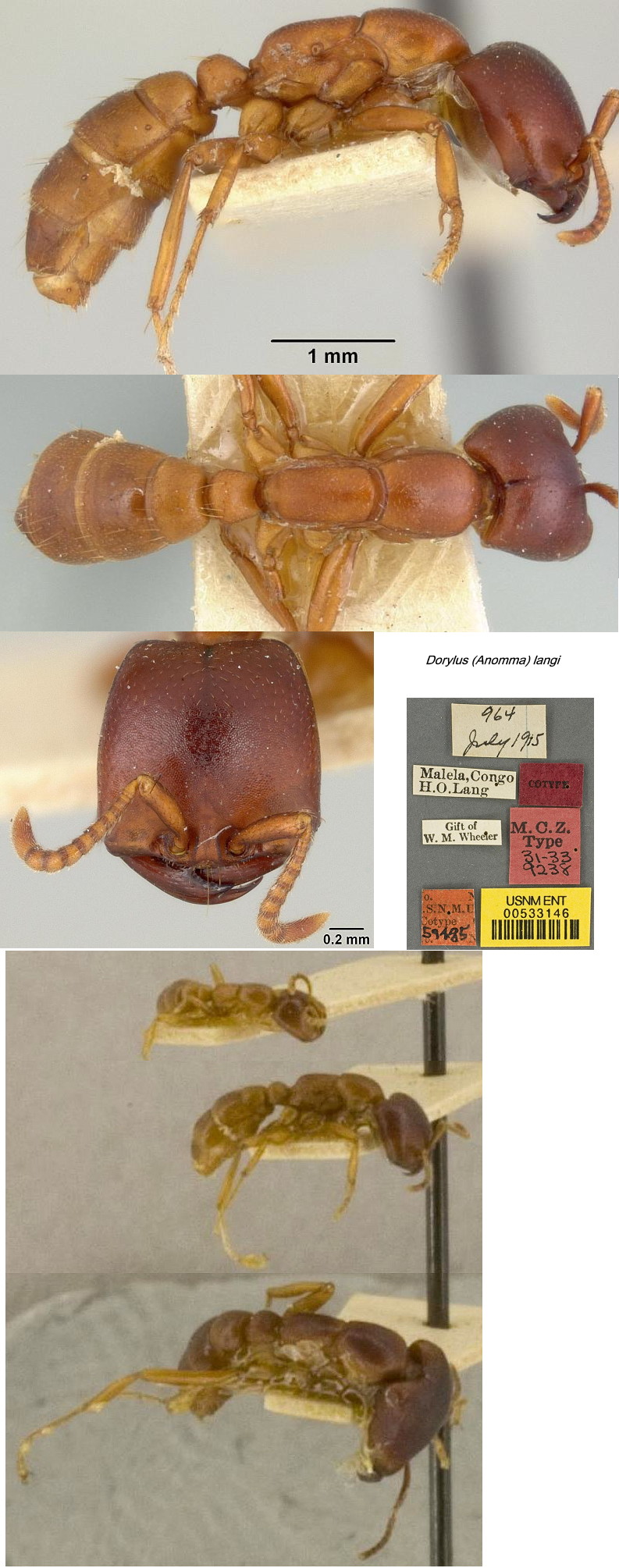 Wheeler
(1922) gave the following description Dorylus (Anomma) kohli
variety langi, new variety. Wheeler
(1922) gave the following description Dorylus (Anomma) kohli
variety langi, new variety.
A series of more than a hundred workers from Malela
(Lang and Chapin), taken beneath the prostrate trunk of a palm,
represent a new variety near variety frenisyi Forel and variety
minor Santschi.
Size range from 3 to 8 mm. The largest are very probably
the true maxima workers as they lack the preapical mandibular tooth. In
frenisyi the largest workers attain a length of 8.5
mm, in minor 8 mm.
The head of langi is nearly as broad as long,
its sides convex and distinctly converging behind so that the occipital
border, which is deeply and rather angularly excised, is about
three-fourths as long as the anterior. The dorsal and ventral surfaces
of the head are somewhat flattened. The whole body is finely, sharply,
and rather uniformly shagreened or minutely and densely punctate and
subopaque; the mandibles smooth and shining; the gaster behind its
first segment feebly shining. The upper surface of the head, thorax,
and gaster are uniformly but sparsely punctate, the punctures
nonpiligerous for the most part. The suberect, yellow hairs are very
sparse and confined to the gaster and the same is true of the dilute
appressed pubescence. Legs and scapes with short stiff and appressed
hairs, absent or very sparse on the extensor surfaces of the femora and
tibiae. In some specimens a few very fine short hairs can be detected,
under a magnification of 20 diameters, arising from the coarse
punctures on the vertex or posterior corners of the head. Colour rather
bright reddish ferruginous, with the legs paler and the mandibles and
the upper surface of the head, except the cheeks and occiput, dark
brown or blackish. The upper surface of the thorax and gaster, except
the posterior borders of the segments of the latter, are darker and
more brownish than the pleurae and venter. The petiole is scarcely
longer than broad, its ventral tooth small, compressed and directed
backward. The smaller workers have the head of nearly the same shape
and proportions as the larger but less deeply excised behind and more
shining, as is also the body. The pubescence is also a little more
abundant. The colour is very similar but paler in the smallest
individuals.
The photomontage of cotypes is collated from The
Smithsonian Institute images at http://ripley.si.edu/ent/nmnhtypedb/public/specimeninfopage.cfm?publicconsumption=1&typespecimenID=959.
See also http://www.antweb.org/specimenImages.do?code=casent0902698
|
Raignier & van Boven (1955) made a single field
collection, with 8 specimens, TL between 7 and 4 mm, CI 95, petiole as
wide as long for TL 6.84; head dark brown, matt anteriorly, shiny
behind; thorax and abdomen generally bright, more so than congolensis.
They thought, however, that the form was no more than an example of the
variability inherent in Anomma species, although they also felt
more strongly that langi is very close to, if not identical
with, victoriae.
|